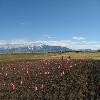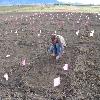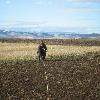The invasion potential and competitive ability of Camelina sativa (L.) Crantz (Camelina) in rangeland ecosystems in south-central Montana
Links and/or abstracts:
2009. SRM meeting. A quantitative protocol to assess the invasive potential of a plant species into a
rangeland ecosystem using Camelina sativa (gold of pleasure, large-seeded false flax) as a model.
Philip B. Davis, Fabian Menalled, and Bruce Maxwell1
We suggest a quantitative approach for proposed plant biofuel species risk assessment. We collected demographic data over two years to assess the probability of the biofuel species, C. sativa, to invade rangeland ecosystems of south-central Montana, USA. Specifically, the objectives of this study were to 1) incorporate demographic data on C. sativa in response to different environments into a population dynamics model, thereby offering a quantitative prediction of invasion potential, and 2) compare these results to predictions suggested by the widely used, qualitative Australian Weed Risk Assessment (WRA) system. Camelina sativa was found to pose a low threat of invasion in the assessed habitats, as positive population growth (λ > 1) was not obtained using observed data. Thresholds to create growing populations could only be achieved by combining large increases in seed survival with large annual inputs of new seed. In contrast to our experimental results, the WRA suggested that C. sativa should not be allowed entry into the region, thus highlighting the need for a more comprehensive approach to assessing invasion potential of proposed biofuel species. Additionally, we suggest methods to combine temporal and spatial quantitative assessments of invasiveness.
Click on an image to view as a slideshow.




